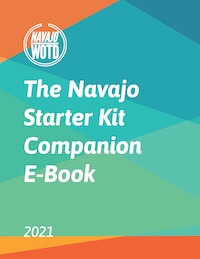dah naat'a'í
flag
dah nah tah ih
This is the Navajo word for “flag.”
The first fragment of this phrase, dah, is in reference to something that is elevated, or in a relatively stationary position high up. You’ll hear it if someone tells you to hang something up in Navajo.
The second part, naat’a’í, is a way of saying something is moving above you. Similar words in English for this would be flying, or rising. For example, chidí naat’a’í (car that is flying) is the word for airplane.
The translated version of the Pledge of Allegiance (USA) begins like this: “United States of America bidah naat’a’í …” You’ll notice dah became bidah, in which bi- denotes “its” flag.
